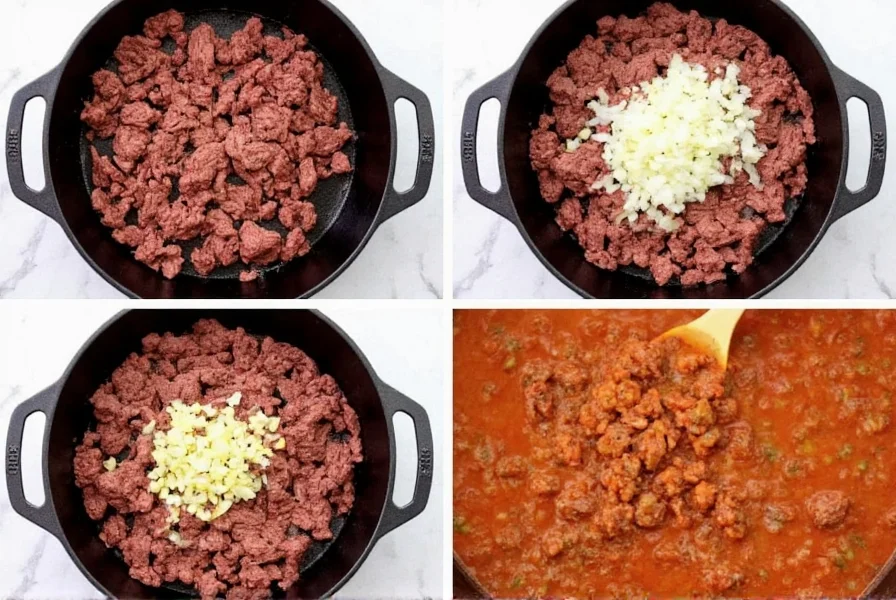There's something special about the combination of smoky chili spices and sweet corn kernels that creates a flavor profile greater than the sum of its parts. This corn chili recipe has become a weeknight staple for home cooks who want a satisfying meal without spending hours in the kitchen. The natural sweetness of corn balances the heat from chili peppers while adding delightful texture to every spoonful.
Why Corn Elevates Your Chili
Corn isn't just a random addition to chili—it serves specific culinary purposes that enhance the overall dish. The natural sugars in sweet corn counterbalance the acidity of tomatoes and the heat from chili spices, creating a more rounded flavor profile. When added at the right stage of cooking, corn maintains a pleasant bite that contrasts beautifully with the tender beans and meat.
Food scientists note that corn contains volatile compounds that interact with capsaicin (the compound that makes chili peppers hot), effectively reducing perceived spiciness while maintaining complex flavor. This makes corn an excellent ingredient for creating crowd-pleasing chili that satisfies both heat-seekers and those who prefer milder dishes.
Complete Ingredient List
What makes this easy corn chili recipe stand out is its balance of quality ingredients without unnecessary complexity. Here's everything you'll need:
| Ingredient | Quantity | Notes |
|---|---|---|
| Ground beef (85% lean) | 1.5 lbs | Alternatively use ground turkey for lighter version |
| Yellow onion, diced | 1 large | Yellow provides better sweetness than white |
| Garlic cloves, minced | 3 | Fresh is essential for best flavor |
| Fire-roasted diced tomatoes | 28 oz can | With juices |
| Red kidney beans, drained | 2 cans (15 oz each) | Rinse to reduce sodium |
| Sweet corn kernels | 2 cups | Fresh, frozen or canned (drained) |
| Chili powder | 3 tbsp | Quality brand makes difference |
| Cumin | 2 tsp | Toast whole seeds then grind |
| Olive oil | 2 tbsp | For sautéing |
| Beef broth | 1.5 cups | Low sodium preferred |

Step-by-Step Cooking Instructions
Follow these simple steps for the best corn chili recipe that's ready in just 30 minutes:
- Brown the meat: Heat olive oil in a large pot or Dutch oven over medium-high heat. Add ground beef and diced onion, cooking until beef is browned and onions are translucent (about 8 minutes). Drain excess fat.
- Add aromatics: Stir in minced garlic and cook for 1 minute until fragrant.
- Build flavor base: Add chili powder, cumin, smoked paprika, and oregano. Cook for 2 minutes, stirring constantly to toast the spices.
- Combine liquids: Pour in fire-roasted tomatoes (with juices) and beef broth. Bring to a gentle simmer.
- Add beans: Stir in kidney beans and black beans. Simmer uncovered for 15 minutes to allow flavors to meld.
- Incorporate corn: Add corn during the last 5 minutes of cooking to preserve its sweet flavor and slight crunch.
- Season to taste: Adjust salt, pepper, and additional chili powder as needed. For extra depth, add 1 tbsp of apple cider vinegar.
Pro Tips for Perfect Corn Chili
Professional chefs and experienced home cooks agree on these techniques for elevating your chili recipe with corn:
- Layer your spices: Add half your chili powder when browning meat and the rest later for more complex flavor
- Corn timing matters: Adding corn late preserves its sweetness and texture—don't cook it the entire time
- Acid balance: A splash of lime juice or apple cider vinegar at the end brightens flavors
- Texture control: For thicker chili, mash some beans against the pot side before adding corn
- Resting time: Let chili sit off heat for 10-15 minutes before serving for flavors to fully integrate
Delicious Variations to Try
This versatile corn chili recipe adapts beautifully to different dietary needs and flavor preferences:
Vegetarian Corn Chili
Substitute ground beef with 2 cups cooked lentils and 1 cup chopped mushrooms. Use vegetable broth instead of beef broth. Add 1 tbsp soy sauce for umami depth.
White Chicken Corn Chili
Replace beef with 2 cups shredded cooked chicken. Use white beans instead of kidney beans, and add 1 diced green chile pepper for authentic Southwestern flavor.
Spicy Chipotle Corn Chili
Add 2 minced chipotle peppers in adobo sauce plus 1 tsp adobo sauce. The smoky heat complements corn's sweetness perfectly.

Serving Suggestions and Storage
Corn chili shines when paired with complementary sides and toppings:
- Classic toppings: Shredded cheddar, sour cream, diced red onion, fresh cilantro
- Perfect pairings: Cornbread, saltine crackers, or avocado slices
- Make it a meal: Serve over baked potatoes or rice for heartier portions
Store leftovers in an airtight container in the refrigerator for up to 4 days. Chili actually tastes better the next day as flavors continue to meld. For longer storage, freeze portions for up to 3 months—just leave out dairy toppings until serving.
Common Mistakes to Avoid
Even experienced cooks can make these errors when preparing chili with corn:
- Overcooking the corn: Adding corn too early makes it mushy and loses its sweet flavor
- Skipping the spice toast: Raw spices taste dusty—always cook them briefly in oil
- Using low-quality chili powder: Freshness matters—replace spices every 6 months
- Not draining beans: Excess liquid from beans makes chili watery
- Rushing the simmer: At least 15 minutes of simmering is needed for flavors to develop
Frequently Asked Questions
Can I use frozen corn in chili instead of fresh?
Yes, frozen corn works perfectly in chili recipes. In fact, many chefs prefer frozen corn because it's flash-frozen at peak ripeness, often making it sweeter than fresh corn available off-season. Simply add frozen corn directly to the chili during the last 5 minutes of cooking—no need to thaw first.
Why does my corn chili turn out too watery?
Watery chili usually results from not reducing the liquid sufficiently or adding too many liquid ingredients. To fix this, simmer uncovered for additional 10-15 minutes to evaporate excess liquid, or mash some of the beans against the pot side to naturally thicken the chili. Always drain canned beans thoroughly before adding to your chili recipe with corn.
What's the best type of corn to use in chili?
The best corn for chili depends on the season. In summer, fresh corn provides exceptional sweetness and texture. Off-season, high-quality frozen corn often outperforms fresh supermarket corn. Canned corn works in a pinch but should be thoroughly drained. For best results in your easy corn chili recipe, use 2 cups of corn regardless of type.
How can I make corn chili less spicy without losing flavor?
To reduce spiciness while maintaining flavor in your chili recipe with corn, add natural sweeteners like a tablespoon of honey or maple syrup, or increase the corn quantity which naturally balances heat. Dairy elements like a dollop of sour cream when serving also counteract spiciness. Remember that corn's natural sugars help moderate heat, so don't skip this key ingredient in your corn chili.











 浙公网安备
33010002000092号
浙公网安备
33010002000092号 浙B2-20120091-4
浙B2-20120091-4